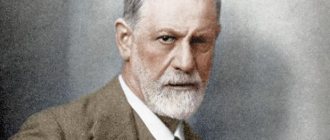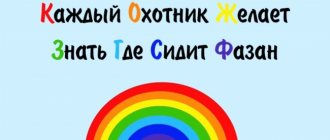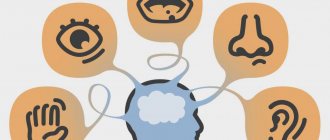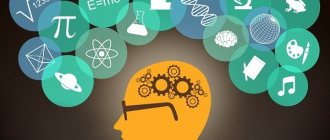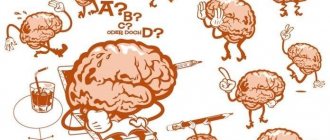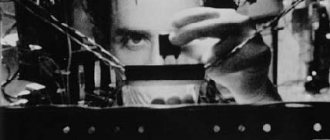Memory is a process occurring in the human psyche, through which material is accumulated, saved and displayed. Memory in psychology is the definition of the brain’s ability to perform the functions of remembering, storing and recreating experience. Also, this mental process allows a person to remember experiences and events of the past, consciously thinking about its value in his own history and comprehend the feelings and emotions that are associated with it. This process allows a person to expand his cognitive abilities. This property also has a complex structure, consisting of several functions and processes that ensure the perception of information from the surrounding reality and its recording in past experience. Internal memory is a complex process in which the perception, accumulation, storage, systematization and very rapid reproduction of information is carried out.
General classification
There are a large number of classifications of memory in domestic and foreign psychology.
If you need to study this material in detail, you should look at the works of P. P. Blonsky, R. S. Nemov, F. N. Shemyakin, D. O. Hebb and other specialists. There are only the main types; psychology identifies the following:
In fact, in addition to the main types of memory, descriptions of others can be found in the works of psychologists. For example, the classification according to the nature of mental activity sometimes also includes:
- sensory - visual, when fixation occurs at the moment of blinking;
- eidetic - combined, when visual impressions (which form its basis) are reinforced by others (auditory, gustatory, tactile), which allows subsequently to reproduce an unusually vivid image;
- social - preservation of socially significant information accumulated by previous generations;
- spatial - visual, allowing you to navigate the area well, remembering the features of the route.
The classification by duration is expanded by such a type as ultra-short-term memory (another name is the sensory register) - retaining information for several seconds. Includes iconic (for fixing visual material, lasts less than a second) and echoic (for acoustic, lasts 2 seconds).
Some psychologists classify types of memory into a separate group based on the type of organization of memorization:
- episodic - storage of specific information limited to a certain period (about a concert, for example);
- procedural (automatic) - a way of performing an action without taking into account its content, through skills brought to automaticity (driving skill).
Within each typology, several more species are distinguished. Psychologists are actively engaged in their classification to this day, constantly expanding and improving it.
Physiology of the memory process
The ability to retain information is not unique to humans. Animals with a developed central nervous system can also remember and reproduce data (migratory birds know routes). The volume and duration of data storage depends on the number of nerve cells involved in the process.
Information recorded in short-term memory is transferred to long-term memory through a complex biochemical process. The neurons that make up the brain work like a recording device - they remember information and store it. Data is recorded not on individual neurons, but on a neural network - a stable collection of cells.
When a person remembers information, neurons become active. The data travels along the fibers and reaches the cluster. For information seen earlier, there is a ready-made accumulation in the brain. For data that a person learned for the first time, a new neural network is formed. There are connections between networks. A disruption in the functioning of at least one of them leads to the erasure of memories.
Books
It’s not for nothing that I wrote about poetry in my advice. They train and increase memory capacity. Books work the same way.
Reading develops memory, because when we read, images arise, we remember the plot, we experience it. Very useful reading. And reading about the development of our mental processes is even more useful.
Therefore, I suggest you take the time to study super books:
- Denis Bukin “Development of memory using the methods of special services”
- Ryuta Kawashima “Train your memory. Japanese system for maintaining brain health”
- Jonathan Hancock “How to train your memory. Don’t think about memory - better use it to the fullest!”
- Stanislav Matveev “Phenomenal memory. Methods for memorizing information”
- Kevin Horsley “Limitless memory. Remember quickly, remember for a long time"
By the nature of mental activity
Depending on what mental activity predominates in human activity during the recording and reproduction of information, there are the following types of memory.
Motor
Other names: motor.
Definition in psychology: fixation, retention and reproduction of motor algorithms, their amplitude, duration, speed, direction. It is formed in a part of the brain called the reticular activating system.
Why is it needed: contributes to the development of a number of skills (domestic, sports, labor), as well as learning to write.
Examples:
- the simplest movements that a person learns from childhood: how to walk, hold a spoon, brush your teeth, comb your hair;
- playing tennis, team sports, swimming, gymnastics, aerobics, exercise equipment;
- knitting, embroidery;
- cutting food, peeling vegetables and fruits;
- drawing, modeling, wood carving;
- dancing;
- playing musical instruments.
Who is especially well developed: athletes, secretaries, dancers, jewelers, watchmakers, surgeons, assembly line workers.
Development methods:
- Exercise. Master different sets of exercises.
- Develop fine motor skills (sculpt, assemble puzzles and Legos).
- To take dance classes. Learn new directions.
- Develop your hands.
- Learn to play musical instruments.
- Master the ten-finger touch typing method.
- Learn to use Chinese chopsticks.
- Perform exercises that involve completely different movements with your hands (for example, the left hand strokes the table in a circular motion, and the right hand, clenched into a fist, knocks on the table).
Emotional
Definition in psychology: fixation, retention and reproduction of feelings experienced by a person, as well as emotionally charged events. They can be positive and negative. They are formed by a part of the temporal part of the brain called the amygdala. They are deposited in the cerebral cortex. Thanks to the plasticity of the central nervous system, with each subsequent reproduction of the same situation, its brightness is smoothed out.
Why is it needed: feelings experienced and recorded by emotional memory become a kind of signaling system for a person. It either encourages him to act (if the experience was positive) or deters him from it (if the experience was negative). Forms a versatile personality, develops emotional intelligence, promotes social adaptation, and stimulates creativity.
Examples:
- empathy, sympathy (based on experience);
- Love;
- complexes;
- phobias;
- choice of social circle (people move away from those who hurt them in the past).
Who is especially well developed: actors (the famous system of K. S. Stanislavsky is based on it), teachers, psychologists, representatives of social professions.
Development methods:
- Keeping a diary.
- Meditation.
- “Anchoring” positive feelings and emotions.
- Bibliotherapy.
- Master networking and make as many new acquaintances as possible.
- Do what you like.
- Adrenaline: ride a roller coaster, jump from a parachute.
This is interesting. Psychologists say that a person remembers 3 feelings best - fear, suffering, surprise.
Semantic
Other names: verbal, logical, verbal-logical.
Definition in psychology: fixation, retention and reproduction by a person of heard, seen, spoken words.
Why is it needed: allows you to record and reproduce information based on generalized associations that reflect its most important aspects. Uses large structural units for memorization, which are called mnemonic supports. After a while, they are the ones who help a person remember the material.
Examples:
- retelling;
- memorizing poems;
- preparation for exams.
Who is especially well developed: artists, singers, pupils, students.
Development methods:
- Break information into blocks and isolate main ideas.
- Read complex texts every day that are far from your interests, try to understand and remember the information contained in them.
- Before going to bed, remember in detail the past day (week, month, quarter, six months, year).
Figurative
Other names: visual-figurative.
Definition in psychology: fixation, retention and reproduction of visual and sound images, as well as odors.
Why is it needed: to control the balance of functioning of both hemispheres of the brain.
Subtypes:
Who is especially well developed: musicians, artists, writers.
Development methods:
- Master the association method.
- Do neuroscience.
- Learn foreign languages.
This classification is considered basic in psychology. Particular attention is paid to the figurative type.
Operational
In the modern world, there are many gadgets and technologies that help a person with RAM. This method of memorizing information is also used by humans. Working memory in psychology is retained exclusively for performing specific actions; the rest of the time, this information does not emerge in consciousness. This type of memory is superficial and small in volume. An example would be understanding the meaning of a sentence that comes from seeing a pair of words. But it happens that there is not enough memory for particularly long sentences. In order not to encounter this, it is necessary to develop types of memory based on the duration of information storage.
Sensory
It is considered one of the main types of memory, being its first stage. Information is received with the help of nerve endings, has a short storage time of information and elementary content. The average storage time will be about 4 seconds. The scheme of sensory memory in the most studied types is based on auditory and visual, and olfactory memory is also taken into account. With the help of a sensory image, the picture is perceived as a whole, and not in pieces of individual signals. It is with the help of sensors that we perceive a musical track as a complete work, and not individual sounds.
Short term
Acts as the first part of information processing designed for long-term storage. This type of information is stored for no more than 30 seconds and is briefly retained in memory. This time is enough for the brain to study the incoming information, determine the degree of its importance and begin processing. Important data can be repeated and stored for a longer period of time. By focusing your attention, you can retain data for longer, signaling to your brain that the information is considered necessary. If the ability to concentrate is undeveloped, substitution may occur: old information is updated under the sending of new data. Typically this process occurs when there is an abundant flow of information.
Motor
It is based on developing writing skills, learning to play a musical instrument, and achieving sports achievements. A lot of actions are performed unconsciously, thanks to memory, freeing the brain from processing repetitive actions, giving the processing of more important information. Walking is also a consequence of motor memory.
Verbal-logical
This memory is called exclusively human. But some animals can also remember words, and the volume of words is quite large. The difference is that animals do not understand the meaning of words, but perceive them as sounds with a certain sensory image. A person, in turn, remembers words in an abstract semantic sense.
An example is the phrase “food”, where the cat will associate the sound exclusively with the image of food, with the manifestation of reflexes, such as salivation. In turn, a person will not experience such a reflex from one phrase, but will be perceived with a semantic connection.
This type works better if you need to remember not a specific word, but full-fledged sentences arranged in a text. Types of memory and their characteristics are individual.
There is a separate division by type, where types of human memory are divided into voluntary and involuntary:
Involuntary
The process of memorization is uncontrolled and occurs on its own, without resorting to the help of consciousness. This memory starts working under certain criteria. Typically, such memory is used to remember vivid events, something unusual or important.
free
It is used where it is necessary to retain important information in the mind, but at the same time not interesting. These include acquiring knowledge during school years.
Selected recommendations
To increase the effectiveness of your training, follow these recommendations from neuroscientists:
- Explore new horizons.
- Visit as many new places as possible: exhibitions, museums, quests, panoramas.
- Learn and regularly perform one of the breathing exercises.
- Give your brain a good rest for 15 minutes every day. Dim the lights, turn on relaxing music and try not to think about anything.
- Move more. Play sports. Take a walk.
- Try to be outdoors more often. Ventilate the rooms you are in.
- Repeat important information that will be useful to you tomorrow before going to bed.
- Avoid lists (memorize information) and calculators (do calculations in your head).
- Read books, learn languages, memorize poetry.
- Use online trainers: Wikium, Zanimatika, B-trainika, Supermozg, BrainApps.
How does a person remember
What kind of mood does a person have - types in psychology
What kind of memory a person has depends on the type of his activity and characteristic features.
Additional Information. It is known that blind and deaf people have heightened other senses. The perception of the world and types of memory change.
Receipt of signals
The human brain is a perfect device. He is capable of retaining and restoring a huge amount of information, but is selective in remembering and reproducing. What happens in ordinary conscious life does not linger in a person’s memory for long. There are laws here:
- what is used in practice is better absorbed;
- It’s easier to remember new things by associating them with familiar concepts;
- new information overlaps similar old information;
- for better memorization there is an optimal row length;
- repetition of information promotes better memorization;
- unfinished actions, tasks, unspoken phrases are retained in memory longer.
All data enters the brain in different ways. Scientists suggest that all parts of the brain are involved in the processes of remembering, storing and retrieving data.
Study methods
To study a person’s ability to remember and process information, they use:
- Collection of information - studying the biography of the subject, observation, conducting experiments and tests, studying the results of activities.
- Analytical biochemistry. Conducted based on the results of clinical studies.
- Electrophysiology. Brain activity is recorded using magnetic resonance imaging.
- Pharmacology. The effects of various stimulant drugs on brain activity are being studied.
- Clinical psychophysiology. The subject's behavior is observed in a clinical laboratory setting.
If necessary, it is possible to study not only human memory. Scientists conduct experiments on mammals, plants and even microorganisms.
Differences between short-term and long-term memory
Short-term and long-term types of memory represent two stages of one development. Long-term memory functions perfectly only with good short-term memory, which is a kind of buffer for the advancement of selected information.
Short-term memory allows you to remember what you hear and see without a special purpose or special effort. It is of great importance for the formation of life experience and the organization of thinking.
Long-term memory is the most complex and important of all types. Everything that is held in the field of attention for more than a few minutes is stored in its system for a long time. Only recycled and conscious materials go there. All this is reminiscent of the work of a modern computer, but more advanced, with huge amounts of various data.
The brain is like a computer
The main difference between short-term and long-term memory is the volume of memorized material. The limits of the human brain remain unknown. But even what is known is amazing - so much information is not contained in the largest libraries. In ordinary life, a person does not use all the functions and capabilities of his perfect brain structure. Due to the huge amount of information, there are serious problems with finding it.
Violations
Disorders include underdevelopment of long-term memory, when a person simply does not know how to correctly encode and reproduce information, and complete amnesia, which is characterized primarily by damage to the hippocampus. If in the first situation everything can be corrected through constant training, then in the second the forecasts most often remain unpredictable.
Causes
Physiological:
- asthenia;
- liver intoxication;
- damage to the central nervous system and brain: head injury, post-stroke condition;
- intellectual disorder, schizophrenia;
- chronic alcohol or drug intoxication.
Mental:
- overwork;
- neuroses;
- constant stress;
- excessive emotional and mental stress;
- depression;
- psychotrauma;
- dysthymia: constant bad mood.
Household:
- poor nutrition;
- lack of sleep;
- excessive physical and intellectual stress;
- improper planning of the day, lack of routine.
Symptoms
- Difficulties with conscious memorization: poems, dates, exam material learned by heart are poorly retained in memory and are reproduced with errors;
- inability to remember events from the distant or near past, memory lapses;
- confusion, violation of cause-and-effect relationships;
- forgetfulness in basic everyday situations: didn’t make a report, didn’t come to a meeting, didn’t buy bread for home;
- social maladjustment;
- decreased mental capacity and performance;
- inattention, inability to focus and concentrate;
- confusion.
If violations of short-term memory lead primarily to everyday problems (when you don’t remember what you did 5 minutes ago), then the consequences of damage to long-term memory affect almost all areas of life. At work, this leads to poor performance of one’s duties, and in the family – to the breakdown of personal relationships. The person turns out to be socially maladapted. Even if his DVP is simply poorly developed, he will not be successful compared to other students (students, employees), not to mention various forms of amnesia.
For more information about what causes memory impairments, how they manifest themselves and how to get rid of them, read our separate article.
Causes of memory loss
Have you promised two employees a meeting at the same time? Or have you already forgotten what you ate this morning? Or maybe you don’t remember at all whether that ill-fated iron was turned off?! Your affairs are getting worse...
Indeed, every person has moments of memory deterioration, and for many this is already a tendency.
Reasons for the deterioration of this cognitive process:
- Nervous exhaustion, stress. The brain is aimed at protecting, not at nourishing mental functions.
- Constant lack of sleep. During sleep, the brain restores the entire body. If there is little sleep, it does not have time to do this, and it itself loses its power.
- Alcohol and drug abuse. Memorization is the first thing that suffers from all mental functions. Chemicals have a negative effect.
- Previous anesthesia, medications.
- Lack of B vitamins. These are important substances for the nervous system. If they are deficient, memory will also suffer.
- Various diseases.
If memorization deteriorates, you should not leave it to chance. We urgently need to work on this!
Diagnostics
To find out how well a person's long-term memory is developed, various test methods are used.
Method No. 1. Memorizing words that are logically unrelated to each other
The bottom line. The subjects are given 2 lists of words (for children 6-12 years old one will be enough), which are logically unrelated to each other. Each of them is numbered.
Recommended Material:
Task options:
- Lists can be read aloud (without allowing subjects to write them down). If the words are read out, this must be done 2-3 times for adults and 4-5 times for children 6-12 years old.
- They can be written on the board.
- They can be distributed on separate pieces of paper to each subject.
Exercise:
- Listen/read the lists of words carefully and try to remember them.
- After listening/reading multiple times, try to reproduce it on paper. Preferably in the same order.
- Next, you need to be distracted by some other activity.
- After half an hour, the lists are read/listened to one more time and played again.
- The same thing is done twice more - the next day and a week later. The words are read/listened to again, but only once.
The results of all 4 tests are calculated using the following formula:
C (DVP coefficient) = B (number of correctly reproduced words): A (total number of words) x 100.
Next, the arithmetic mean of all 4 tests is found and based on the resulting result, conclusions are drawn:
Method No. 2. Memorizing text with semantic connections
The essence of the technique is almost the same. Only the text is not read aloud, but is distributed to each subject. At the same time, attention is drawn to the fact that the main thoughts are highlighted in bold, which must then be reproduced. That is, it is not necessary to memorize the sentences themselves and the entire text.
This technique is used to diagnose DVP in adolescents (13-17 years old) and adults.
Card with text:
You need to reproduce the main ideas of the text immediately after reading, then after half an hour, the next day and a week later. The results of all 4 tests are calculated using the formula:
C (DVP coefficient) = B (number of correctly reproduced thoughts): A (total number of highlights in the text) x 100.
Next, the arithmetic mean of all 4 tests is found and, based on the resulting result, conclusions are drawn according to the table above.
In case of serious impairments of long-term memory, laboratory diagnostic methods (EEG, CT, MRI, ultrasound) are performed.
Games
There are many games for children, teenagers, adults and even seniors that help train this cognitive process.
A game for developing auditory memory. Your partner must read a couple of words, and you must remember them:
- bun - flour;
- sister brother;
- sweater - thread;
- father - son;
- carriage - rails.
Then the playing partner says the first word, and you say the second.
A game to develop visual memory. A person is given the task of looking at a series of numbers and remembering them in the correct order in 30 seconds. For example: 3, 5, 4, 7, 8 (the row can be continued if desired).
Then the numbers are closed and the following questions follow:
- What number is to the right of 4?
- What number is between 3 and 5?
- What are the two numbers to the left of 7?
- What number will you get when you add the first three digits?
A game to develop associative memory. A very useful game. Associations are one of the most effective ways to memorize information and memory training techniques. Suitable for children who can write and adults.
You need to come up with definitions for the words, describing the specified nouns in detail with adjectives. The original words are not written down, but dictated. Definitions should not be repeated:
- doll - …;
- screwdriver - ...;
- river - ...;
- Mother - …;
- tree - …;
- sky - …;
- letter - …;
- soup - …;
- envelope - …;
- toy - …;
- computer - …;
- Instagram -...;
- house - ... and others.
And after the list of definitions, the person needs to say the original words for each of them.
A game for memorization speed and development of mental abilities. Someone in the company is asked to name 5 objects or names in the allotted time. For example, the names of girls: Yana, Olya, Yulia, Sveta, Lena. This is the first stage. Then we complicate it. You need to name 5 objects of a given shape or color. For example, round objects: the sun, a ball, a flying saucer, just a plate, a New Year's toy.
You need to repeat the first chain (with names) and name your own, for example, square-shaped objects. The next player needs to repeat the chain with round objects and come up with his own. And so on.
Methods of training and development
If a person does not have physiological disorders, he can improve memory function: speed up memorization and increase volume. Simple exercises designed for children and adults are suitable for this.
Development in children
You can notice a lag in the development of memory in children at a young age, but until the age of 3-4 years, parents do not worry about it, and turn to a psychologist when the child is about to go to 1st grade. And although time is lost, the situation can be helped.
To develop visual memory, the “Story Pictures” method is used. Cards are laid out in front of the child, depicting a short story. The preschooler examines it for some time. When he is ready, the adult needs to swap the cards. The child’s task is to restore the sequence of actions. For auditory memory, exercises for memorizing words and numbers are suitable. You need to start with three, gradually working up to 6–7.
Development in adults
You can train your memorization skill with any material: retell the plot of a movie, memorize poems, phone numbers, words of a foreign language. You can study during a break at work, using improvised objects. For example, lay out stationery on the table, take a photo, change places and arrange them as they were in the beginning.
Main characteristics
Visualization + sensory
Reproduction of visual images first of all, all others are secondary and only follow visualization. The eidetic initially remembers the picture: a sandy beach, a blue ocean, a sun lounger, vacationers, palm trees. When he introduces her after a while, he will be able to tell what he was holding in his hands at that moment (touch), how bitter the cocktail was (taste), what his companion said (hearing), what perfume she was wearing at that moment (smell) and even how hot the sun was (“body memory”).
Detailing
The smallest depiction of images: details that no one pays attention to are remembered. For example, how many buttons were on the jacket or how many lines were on the page. First of all, these nuances concern the visual image. It’s not for nothing that eidetic memory is also called photographic. It’s as if a person takes out a snapshot of an event in his head and describes it.
Involuntary retention
Initially, a person does not set himself the task of remembering something specific; all this is deposited in his consciousness on its own. However, this property is characteristic only of born eidetics. Those who develop their photographic memory, of course, do it purposefully.
Random Play
A person can remember the desired image at any time.
Large volumes
Naturally born eidetics, as a rule, simply have an endless storage of memory. That is why they surprise others by the fact that they can easily speak 20 different languages, accurately quote classics, and know all of Shakespeare by heart.
Brightness of images
Conventional memory is characterized by the gradual erasure of images. Years later, we vaguely imagine the faces of people we haven’t seen for too long, we forget their names, and we barely remember the circumstances of our acquaintance. Eidetics, having experienced something once, will never forget it. If at the age of 20 they were introduced to some mutual acquaintance with whom they never even crossed paths, at 50 they can easily tell what his name was, what he was wearing and what timbre of his voice he had.
What types of memory can be developed
Throughout his life, a person uses different types of memory. In the left and right hemispheres, acquired various knowledge is deposited like “bricks”. To extract the necessary information sometimes requires considerable effort. With the help of forgetting, the nervous system is unloaded; this is considered a normal process.
Bad memory and good memory sometimes mean completely different things. For some, it is important to remember everyday trifles, for others, people and events, and others are interested in the amount of information before an exam or an important presentation. Therefore, it is important to know what kind of memory needs to be developed to solve problems. Conventionally, it is customary to distinguish between two types:
- Natural memory. It is as it is, and is inherent in nature itself. Everyone uses it without exception.
- Artificial. It must be trained and developed throughout life.
There are people with phenomenal memory. Others can't hold anything in their head for more than a minute. Experts are confident that the ability to remember can be trained and developed, just like your own body. If you take this seriously, you can achieve significant success.
Memory Features
Important! The testing method can reveal the type of memory in any person, as well as the presence of any pathologies.
Causes of memory impairment and increased forgetfulness:
- age-related changes;
- Alzheimer's disease and some other diseases;
- lack of water in the body;
- absent-mindedness;
- bad dream.
Memory development has a positive effect on a person’s abilities. For adults, this process is more difficult, since regular training is not needed in monotonous work and everyday life.
Useful qualities to improve the memorization process:
- attentiveness and observation;
- interest in life, positive attitude;
- organization in everyday life;
- use of imaginative thinking;
- learning foreign languages;
- Reading books;
- memorizing poems and quotes;
- Mind games;
- physical exercise;
- proper nutrition;
- the ability to correctly express your memories;
- reflections before going to bed about the past day, listing tasks for the next.
If you follow the advice and recommendations of experts and know the characteristics of human memory, then its comprehensive development is possible. Developed memory is valued and helps to achieve a high position in society. This is also important for successful work in all areas.
Courses
If you need more practice, then you did the right thing by reading this far. Here I will describe powerful tools for memory development.
The programs below are also effective for people aged, even after 60 years. I would say that they are not just effective, but vital.
The course for memory development from BrainApps contains the best methods, exercises, and techniques. Here you will learn to remember even complex information.
Benefits from the course:
- better memory of details;
- remembering important dates;
- easy learning of foreign languages;
- effective training;
- excellent orientation in unfamiliar places;
- quickly remembering people's names and faces.
Course program: 7 lessons, 7 simulators, introductory and final tests, adaptation of the program to your success. Cost – 490 rub.
The Mnemonics course from Vikium is a unique lesson with a set of mnemonics. Benefits from the course:
- ability to remember 100 names in 30 minutes;
- the opportunity to congratulate you on your birthday on time;
- ability to memorize phone numbers by ear;
- the ability to keep important numerical data in your head, remember agreements and agreements;
- the ability to instantly learn poetry.
The program includes 7 online simulators, memorization techniques, introductory and final tests, and an individual development program. Cost – 990 rub.
We also took care of you and collected 7 effective mnemonics for developing the mind and memory. I recommend you try it!
How to improve memory and develop attention from Advance is an intensive course that will help you remember what you read 2 times better, avoid age-related memory changes, and learn foreign languages 6 times faster.
The program includes:
- exercises;
- fast memory technologies;
- fight against forgetting;
- an explanation of how age and training affect cognitive function;
- information translation technologies.
The author is Nikolai Yagodkin, a leading specialist in teaching and learning technologies. The lesson is free and a certificate is issued upon completion.
In the selection of memory development courses you will find even more useful programs.
Medical supplies
The use of medications or dietary supplements does not lead to any negative consequences. However, when choosing products, it is important to take into account the person’s age, possible side effects, contraindications, as well as their effectiveness. To do this, just study the instructions and read reviews on the Internet. Additionally, it is recommended to consult a doctor, which is especially important for people with chronic diseases. What should you take to improve your memory?
Over-the-counter
Glycine has become the most popular drug for eliminating inattention and strengthening memory in Russia. The drug is inexpensive and quite effective. Its main advantage is not only the effect on memory, but also the reduction of stress. It is enough to take Glycine 1 tablet 3 times a day.
What other drugs can you pay attention to:
- Vitrum Memory;
- Undevit;
- Bilobil;
- Intellan;
- Aminalon.
All of them have a positive effect on memory quality. These tools are especially effective for schoolchildren, students, and anyone whose work requires interaction with large amounts of information.
Prescription
You can get them only after consulting a doctor. All of them are dispensed from the pharmacy strictly according to a prescription. Such medications easily eliminate inattention, relieve forgetfulness, and also have a special effect on the body if necessary. Piracetam has gained great popularity, as it reduces the risk of developing Alzheimer's disease, while simultaneously strengthening memory and eliminating circulatory disorders in the brain. Also known in our country is Cavinton, which improves the condition after a stroke and other brain diseases. Additionally you can consider:
- Phezam;
- Nootropil;
- Phenotropil;
- Encephabol;
- Picamilon;
- Cerebrolysin;
- Noofen.
For prescription drugs, the list of possible side effects and contraindications is much wider, which must be taken into account.
Taking medications or dietary supplements alone is not enough to develop memory. They should be used exclusively as an additional method in combination with others.
Preventing memory loss
I will write very simple steps to maintain your mental health. But the decision is yours whether to implement them or not.
Here is a short reminder on the development, prevention and restoration of memory:
- Keep your brain sharp. Participate in programs, courses, do exercises and everything that tones up the main human computer. Close your eyes and make some movements from memory, walk by touch.
- Concentrate. Try to pay attention to little things: signs, shoes of passers-by, hairstyles, etc.
- Repeat out loud. This trains several cognitive processes at once.
- Relax. Find and use methods to relax your brain.
- Eat right. No fatty foods, because fat makes the brain lazy. Use unsaturated fats and acids.
- Go for walks. This enriches the brain cells with oxygen, and the brain begins to work better.
- Ensure normal sleep. On the right pillow, enough time. And if you can’t get enough sleep several times, take a rest day. And remember: lack of sleep accumulates!
Stages of information processing when memorizing
If we talk about the structure and mechanism of perception, analysis and sending for storage into memory of any information received, then this happens at the following levels.
- Sensory processing of any data. Fractions of a second are allotted for this period. Everything is remembered briefly and put aside for longer storage only if it has been analyzed as valuable.
- At the next stage, the received data is sent for storage. If they are used in the very near future and a person uses them almost immediately, then this type is called short-term. This includes, for example, orders at work that need to be completed during the current working day.
- Next comes long-term or long-term. This place is a repository for everything important that will be used over a long period of life. As a rule, this includes all acquired skills and life experience, knowledge and abilities, memories and impressions.
- RAM is similar to internal computer memory. This type is used when you need to work with small amounts of information over a long period of time. Despite its similarity with short-term, there are still certain differences between them.
- Tertiary memory refers to long-term memory. Most often used to store language arrays.
Sources
- https://ponervam.ru/vidy-pamyati-u-cheloveka.html
- https://mystroimmir.ru/psihologiya/pamyat.html
- https://Plachu.net/obshhaya-psihologiya/vidy-pamyati-cheloveka
- https://srazu.pro/teoriya/vidy-pamyati-cheloveka.html
- https://ponervam.ru/dolgovremennaya-pamyat.html
- https://rptp-rd.ru/rasstrojstva/vidy-pamyati.html
[collapse]Tweet Pin It
